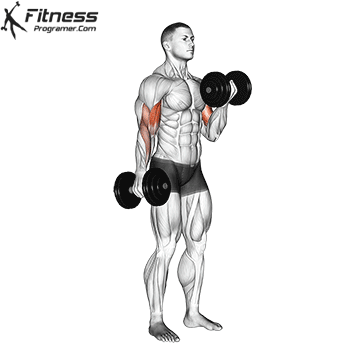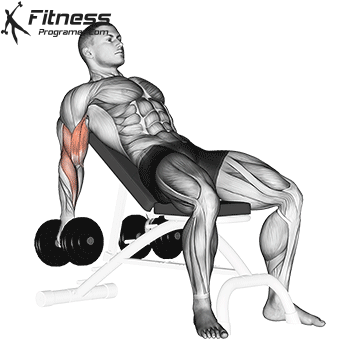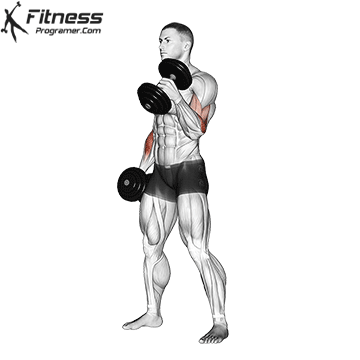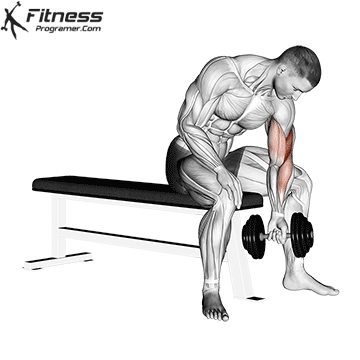The biceps are one of the most visually impressive and functional muscle groups, helping with pulling, lifting, and carrying in daily life. Whether you’re aiming for aesthetic appearance or functional strength, training your biceps effectively is key. With just a pair of dumbbells, you can perform a variety of exercises to tone and strengthen these muscles.
Why train biceps with dumbbells?
Dumbbells offer unique benefits including:
- Improved range of motion: Dumbbells allow for a greater range of motion than some machines.
- symmetry: Training with dumbbells helps correct muscular imbalances.
- comfort: You can use dumbbells at home, in the gym or when traveling.
Biceps dumbbell training plan
Do this routine twice a week.
- Warm up: 5-10 minutes of dynamic stretching or light cardio.
- Cool down and stretching: End your session with 5-10 minutes of stretching exercises. Focus on the muscles you trained to improve your flexibility and aid recovery.
1. Biceps curl with dumbbells

- Muscle targeted: Biceps brachii
- Procedure:
- Stand with your feet shoulder-width apart and hold a dumbbell in each hand, palms facing forward.
- Roll the dumbbells toward your shoulders while keeping your elbows close to your torso.
- Slowly lower them to the starting position.
- Sets/Reps: 3 sets of 8-10 reps
2. Flexor Incline Dumbbell Curls

- Muscle targeted: Biceps brachii (long head)
- Procedure:
- Sit on an incline bench and hold the dumbbells with your arms fully extended.
- Roll the dumbbells toward your shoulders, keeping your elbows stationary.
- Lower them slowly.
- Sets/Reps: 3 sets of 8-10 reps
3. Hammer curl

- Muscle targeted: Biceps brachii, brachialis
- Procedure:
- Hold a dumbbell in each hand with your palms facing your torso.
- Roll both dumbbells upward while maintaining a neutral grip.
- Slowly lower it back to the starting position.
- Sets/Reps: 3 sets of 8-10 reps
4. Concentration curl

- Muscle targeted: Biceps brachii
- Procedure:
- Sit on a bench with your legs spread apart and hold a dumbbell in one hand.
- Place your elbow on the inside of your thigh.
- Rotate the dumbbell up and lower it in a controlled manner.
- Repeat on the other arm.
- Sets/Reps: 3 sets of 12 reps per arm
Tips for effective biceps training
- Focus on the shape: Avoid momentum; Keep the movements slow and controlled.
- Progressive overload: Gradually increase the weight or repetitions to continue to challenge your muscles.
- Incorporate variations: Consider another try Biceps exercises to target different areas of your muscles.
- Peace and relaxation: Give yourself at least 48 hours of rest between biceps workouts to promote recovery and growth.
FAQ: Biceps training with dumbbells
1. How often should I do biceps training with dumbbells?
You can train your biceps twice a week, resting at least 48 hours between sessions to allow for muscle recovery and growth.
2. What dumbbell weight should I start with?
If you are a beginner, start with light weights (5-10 pounds) to focus on form and technique. Gradually increase the weight as your strength improves.
3. Can I build big biceps using just dumbbells?
Yes! Consistent training, progressive overload (increasing weight or repetitions), and proper nutrition can help you build bigger and stronger biceps using dumbbells alone.
4. How many sets and reps are best for building biceps?
For muscle growth (hypertrophy), aim for 3-4 sets of 8-12 reps per exercise. For endurance, do 12-15 reps with lighter weights.
5. Can I train my biceps every day?
It is not recommended to train the biceps daily as it can lead to overtraining and hinder recovery. Stick to 2-3 sessions per week with rest days in between.
6. Are dumbbells better than barbells for biceps training?
Both have their advantages. Dumbbells allow for greater range of motion and can help correct muscle imbalances, while barbells allow for lifting heavier weights and are therefore great for building overall strength.
7. Can I combine biceps training with other muscle groups?
Absolutely! Combine the biceps with complementary muscle groups such as the back or triceps for a balanced upper body workout. For example:
8. Can biceps training with dumbbells help with fat loss?
While biceps training with dumbbells can tone and strengthen your arms, fat loss requires a combination of strength training, cardio, and a calorie-controlled diet.
9. Do I have to train my triceps if I want bigger biceps?
Yes! Training your triceps is crucial to the overall size and strength of your arm because the triceps make up a larger portion of your upper arm than the biceps.
10. How long does it take to see results from biceps training?
With consistent training and proper nutrition, you can see an improvement in strength and muscle definition within 8-12 weeks.
11. What should I eat to support biceps growth?
Eat a balanced diet with enough protein (chicken, fish, tofu, beans), healthy fats and complex carbohydrates. Stay hydrated and consider a post-workout snack like a protein shake to aid muscle recovery.
12. Are there variations to make biceps training more challenging?
Yes!
- Use a slower tempo when curling (e.g. 3 seconds to raise, 3 seconds to lower).
- Perform isometric holds (pause at the top of the movement).
- Superset biceps exercises with minimal break in between.





